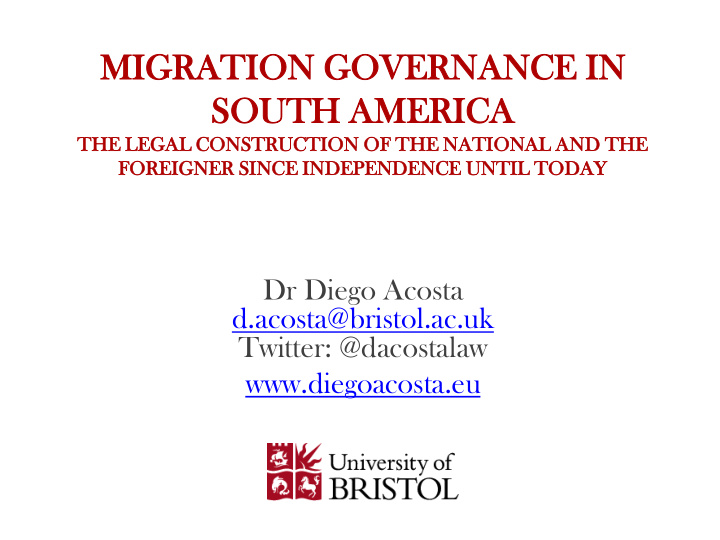



MI MIGR GRATION N GO GOVE VERNAN ANCE CE IN SOU OUTH H AME MERICA THE E LEGAL AL CONSTR STRUCTION UCTION OF THE E NATI TION ONAL AL AND THE E FOREIG IGNER NER SINCE E INDEPENDE PENDENC NCE E UNTIL IL TODAY AY Dr Diego Acosta d.acosta@bristol.ac.uk Twitter: @dacostalaw www.diegoacosta.eu
Discourse • The hu human man right right to to migration migration and the recognition of migrants as subjects of Law, must be at the centre of State’s migration policies. In line with this, we claim the un uncondition conditional al res espect ect of of th the Human uman Rights Rights of of migrants migrants … and we condemn all xenophobic, discriminatory and racist acts … regardless of their migratory status, and reject eject any any at attemp tempt to to criminal criminaliz ize irregu regular lar migration gration.
Translation into Law • National level: Several migration laws, several Constitutions. – Non criminalization of irregular migration. – Right to migrate as a fundamental right. – Open borders. • Regional level. Free movement of people and posible future South American citizenship.
Two claims • Inn nnov ovat ative ve • Ex Excep epti tional onal
Hajime Narukawa´s map
Five Revolutions (Moya) • Demographic in Europe. • Agricultural in South America. • Industrial in Europe. • Transportation for people and goods (steam ships and train). • Liberal. No restrictions to enter South America or to leave Europe.
1880-1980 restrictions Political Ideology After 1929: Post 1960s (Cold War): The Physical or mental disabilities social class . Foreigner as a security threat
1980s back to democracy • HRs intruments ratification. • Emigration countries (Dictatorships, 1980, turn of the century). • Reassesment of the emigrant: from traitor to hero (dual citizenship, voting abroad). • Many undocumented. • Reassesment of regional integration. • Demands of better treatment addressed to EU and USA. • Restrictive laws unconfortably coexisting with new Constitutions.
MI MIGR GRATION TION GO GOVER ERNANC ANCE Consensus Law-Policy Interpretation- Agenda Setting Building change Implementation • Norms, rules, principles and decision-making procedures that regulate the behaviour of the States. • States, IOs, NGOs, Courts, Academics, Unions, Bussinesses, Civil Society, Media.
Migration Governance • IACHR. ACHR. • ICMW. • ILO. International • MERCOSUR. Residence Agreement; Andean Community. Decision 545. • South American Conference on Migration (IOM). Agenda Setting and Consensus Building. • UNASUR. South American Citizenship; Pacific Alliance. Free movement of workers; CELAC, Regional CARICOM . • Implementation. • New Laws. AR, UR, BO, EC, PE, BR and CH, PA. But CO and VE. • Actors. National
Emerging principles at all levels • Non-criminalisation of irregular migration • Right to migrate as a fundamental right and equal treatment. • Open borders and universal citizenship.
EU-South America • Who can move? • Who can move? – Self-sufficient or – Everyone first two years, working. but clean criminal record. Back to irregular. • Rights • Rights – Limited social rights. – Socio-economic equal • Expulsion treatment. – Serious threat. • Expulsion • Enforcement – Unregulated. – Commission and CJEU. • Enforcement. – National Courts mostly.
Challenges
Thank you! Questions and Comments Dr Diego Acosta d.acosta@bristol.ac.uk Twitter: @dacostalaw www.diegoacosta.eu Dr. Diego Acosta
Recommend
More recommend